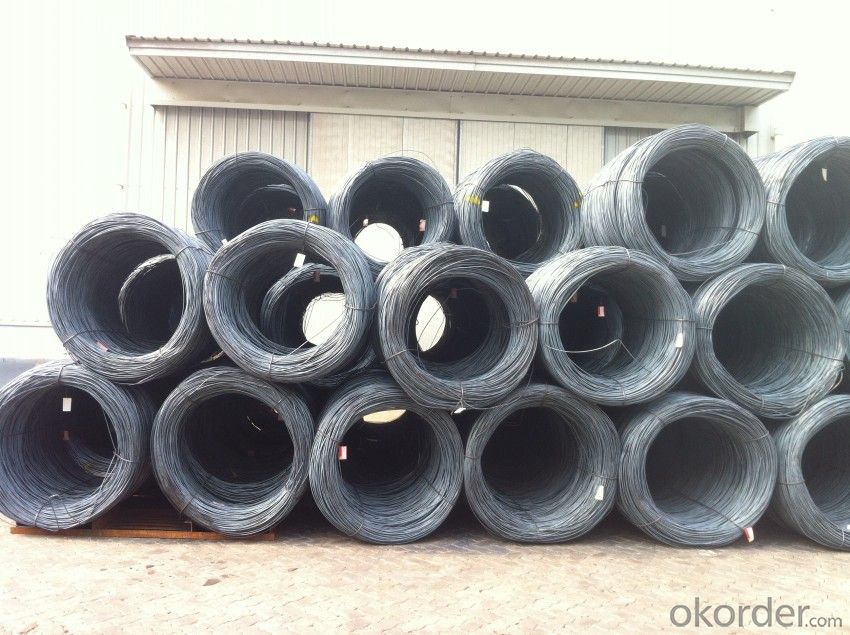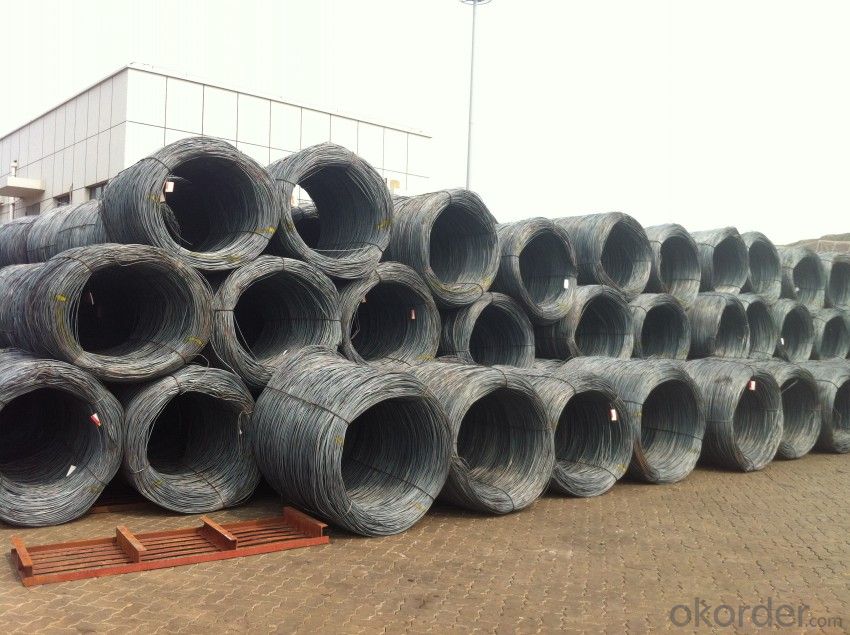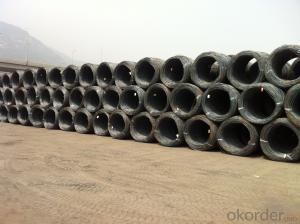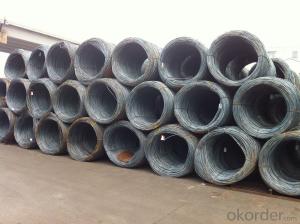Hot Rolled SAE1008 Wire Rods with High Quality
- Loading Port:
- Tianjin
- Payment Terms:
- TT OR LC
- Min Order Qty:
- 25 m.t
- Supply Capability:
- 10000 m.t/month
OKorder Service Pledge
OKorder Financial Service
You Might Also Like
Item specifice
OKorder is offering SAE1008 Wire Rods at great prices with worldwide shipping. Our supplier is a world-class manufacturer of steel, with our products utilized the world over. OKorder annually supplies products to European, North American and Asian markets. We provide quotations within 24 hours of receiving an inquiry and guarantee competitive prices.
Product Applications:
After hot-rolled the products shaped into coil and delivery as finished product, including round, square, rectangular, hexagonal and so on. Since most of the products are round, it is generally called wire rod. Carbon steel wire rod is widely used in construction and manufacturing. Carbon steel wire rod is mainly used for reinforcement of reinforced concrete and welded structure or reprocessed (roberts , nail, etc.) materials, especially used to produce wire drawing, welding electrode, nails, spring, electronic, precise machinery parts and so on.
Product Advantages:
OKorder's Wire Rods are durable, strong, and resist corrosion.
Main Product Features:
· Premium quality
· Prompt delivery & seaworthy packing (30 days after receiving deposit)
· Corrosion resistance
· Can be recycled and reused
· Mill test certification
· Professional Service
· Competitive pricing
Product Specifications:
Manufacture: Hot rolled
Grade: SAE1006 – SAE1008
Certificates: ISO, SGS, BV, CIQ
Length: 6m – 12m, as per customer request
Packaging: Export packing, nude packing, bundled
Grade | Chemical Composition (%) | |||||
C | Mn | S | P | Si | B | |
SAE1006B | 0.03~O.07 | 0.32max | 0.045max | 0.040max | 0.30max | 0.0008min |
Mechanical properties | ||||||
Yield strength(N/mm2) | Tensile strength(N/mm2) | Elongation (%) | ||||
250-280 | 350-380 | ≥32 | ||||
Grade | Chemical Composition (%) | |||||
C | Mn | S | P | Si | B | |
SAE1008B | 0.10max | 0.3~0.50 | 0.050max | 0.040 max | 0.15max | 0.0008 min |
Mechanical properties | ||||||
Yield strength(N/mm2) | Tensile strength(N/mm2) | Elongation (%) | ||||
≥195 | 315-430 | ≥30 | ||||
FAQ:
Q1: Why buy Materials & Equipment from OKorder.com?
A1: All products offered by OKorder.com are carefully selected from China's most reliable manufacturing enterprises. Through its ISO certifications, OKorder.com adheres to the highest standards and a commitment to supply chain safety and customer satisfaction.
Q2:What's your payment terms ?
A2: We can accept T/T,LC at sight and time LC.
Q3: Can you offer the third part inspection certificates ?
A3: Yes, we can apply third part inspection before shipping, such as SGS, BV, etc .
Images:


- Q:How is steel wire rod used in the manufacturing of wire ropes?
- Steel wire rod is a crucial component in the manufacturing of wire ropes as it serves as the raw material for producing high-quality steel wires. The steel wire rod undergoes various processes such as drawing, stranding, and coating to transform it into strong and durable wires. These wires are then twisted and braided together to form wire ropes, which are extensively used in industries like construction, mining, and transportation for applications requiring strength, flexibility, and reliability.
- Q:What are the common applications of stainless steel wire rod?
- Some common applications of stainless steel wire rod include wire mesh for filters and screens, electrical conductors, reinforcement in concrete structures, wire rope for lifting and rigging, and various mechanical components in industries such as automotive, aerospace, and construction.
- Q:How is steel wire rod used in the manufacturing of wire forms for HVAC systems?
- Wire forms for HVAC systems depend on steel wire rod as a crucial element in their manufacturing process. These wire forms play a vital role in providing structural support and stability to the HVAC system. To begin with, the actual wire used in wire forms is produced using steel wire rod. This rod is typically made from high-quality steel, ensuring that the resulting wire is strong and durable. The rod then goes through various manufacturing techniques, such as drawing, annealing, and coating, to achieve the desired wire diameter and properties. Once the wire is formed, it can be used in different ways within HVAC systems. For example, it can be employed to create wire forms that serve as support structures for air ducts. These wire forms establish a robust framework that maintains the shape and integrity of the ductwork. Furthermore, steel wire rod can be utilized to manufacture wire forms that act as reinforcement for HVAC components. For instance, wire grids can be made to support air filters, enhancing their structural stability and preventing collapse under pressure. Wire forms made from steel wire rod can also serve as fasteners or connectors within HVAC systems. They can be shaped into hooks, clips, or springs that securely hold various components together, ensuring a reliable connection. The incorporation of steel wire rod in the manufacturing of wire forms for HVAC systems offers several advantages. Steel's strength and durability make it an ideal material for withstanding the harsh conditions encountered in HVAC applications. Moreover, its excellent corrosion resistance ensures the longevity of wire forms in diverse environments. In conclusion, steel wire rod is an essential material in the manufacturing of wire forms for HVAC systems. Its strength, durability, and versatility make it a suitable choice for creating wire forms that provide structural support, reinforcement, and fastening mechanisms within HVAC systems.
- Q:How is the price of recycled steel wire rod determined?
- The price of recycled steel wire rod is determined through various factors such as the demand and supply dynamics in the market, the quality and grade of the recycled steel, the costs involved in the recycling process, and the prevailing market conditions. Additionally, factors such as global steel prices, raw material costs, and government policies also influence the price of recycled steel wire rod.
- Q:How is steel wire rod used in the manufacturing of wire for medical implants?
- The manufacturing of wire for medical implants heavily relies on steel wire rod, which serves as the primary raw material. The wire is formed through multiple steps, starting with the careful selection of high-quality steel wire rod. This rod is then subjected to various manufacturing processes to create the final wire product. To ensure the highest standards and meet specific medical application requirements, the steel wire rod undergoes a thorough inspection for defects or impurities. This inspection guarantees the production of top-quality wire for medical implants. Once the wire rod passes inspection, it goes through the drawing process. Drawing involves pulling the wire rod through dies to decrease its diameter and increase its length. This process refines the wire's mechanical properties, like tensile strength and flexibility, to meet the demands of medical implants. After drawing, the wire undergoes further processing to improve its surface finish and eliminate any remaining impurities. Processes like annealing are used to heat and slowly cool the wire, enhancing its ductility and eliminating internal stresses. The final step in the manufacturing process involves conducting various quality control measures to ensure the wire's dimensional accuracy and mechanical properties. Tests such as tensile strength, hardness, and surface finish evaluations are carried out. Once the wire meets all quality control requirements and specifications, it can be utilized to manufacture a variety of medical implants. Depending on the specific application, the wire can be processed into coils or springs. Orthopedic devices like bone plates and screws, cardiovascular devices such as stents and guidewires, and surgical instruments like sutures and staples commonly utilize wire. In conclusion, steel wire rod is crucial in the production of wire for medical implants. It undergoes multiple manufacturing processes to ensure its quality, mechanical properties, and dimensional accuracy meet the specific requirements of medical applications. The wire is then utilized to manufacture a range of medical implants, which greatly contribute to enhancing patient outcomes and quality of life.
- Q:What are the common applications of oil tempered and tempered steel wire rod?
- Oil tempered and tempered steel wire rods find extensive use across different industries, owing to their wide range of applications. Some common uses include: 1. Springs: In the manufacturing of springs, oil tempered and tempered steel wire rods are highly sought after. Their exceptional durability and high tensile strength make them ideal for various types of springs, including compression springs, extension springs, and torsion springs. These springs find utility in automotive, aerospace, and industrial sectors. 2. Wire ropes and cables: The production of wire ropes and cables also relies on oil tempered and tempered steel wire rods. These wire rods possess remarkable resistance to wear and fatigue, as well as high strength, making them suitable for applications requiring heavy loads and superior tensile strength. Industries such as cranes, elevators, suspension bridges, and mining equipment greatly benefit from these wire rods. 3. Fasteners: Another prevalent application of oil tempered and tempered steel wire rods lies in the manufacturing of fasteners like bolts, screws, and nails. These wire rods exhibit exceptional strength, toughness, and corrosion resistance, ensuring the reliability and longevity of fasteners in various construction and industrial applications. 4. Automotive components: The automotive industry extensively employs oil tempered and tempered steel wire rods in the production of diverse components. Engine valve springs, clutch springs, suspension springs, and braking systems all utilize these wire rods. Their high performance and durability make them well-suited for demanding automotive applications. 5. Wire mesh and fencing: The production of wire mesh and fencing materials also relies on the utilization of oil tempered and tempered steel wire rods. The strength and resilience of these wire rods make them suitable for creating durable and secure barriers in agricultural, construction, and industrial environments. In conclusion, oil tempered and tempered steel wire rods find wide-ranging applications due to their exceptional qualities such as high strength, durability, and resistance to wear and fatigue. Their usage extends to springs, wire ropes, fasteners, automotive components, as well as wire mesh and fencing, all of which contribute to the efficiency and reliability of numerous industries.
- Q:How is steel wire rod used in the manufacturing of wire forms for jewelry findings?
- Steel wire rod is an essential component in the manufacturing of wire forms for jewelry findings. It serves as the primary raw material that is transformed into various shapes and sizes to create different types of wire forms. The first step in utilizing steel wire rod for jewelry findings is to determine the required diameter and length of the wire. This is crucial as it determines the strength and flexibility of the final product. Once the specifications are established, the steel wire rod is cut into smaller sections, which are then straightened and polished. After the initial preparation, the wire rod is shaped and manipulated using specialized tools and techniques. For example, it can be bent, twisted, or coiled to create different wire forms such as jump rings, ear wires, clasps, and connectors. These wire forms are integral parts of jewelry findings, which are the small components that hold jewelry pieces together. The use of steel wire rod in manufacturing wire forms for jewelry findings offers several advantages. Firstly, steel is a durable and robust material, providing strength and stability to the final product. This ensures that the wire forms can withstand the rigors of everyday wear and tear. Additionally, steel wire rod is resistant to corrosion, making it suitable for long-lasting jewelry pieces. Moreover, steel wire rod allows for a wide range of design possibilities. It is highly malleable and can be easily shaped into intricate patterns and designs, adding aesthetic appeal to the jewelry findings. The versatility of steel wire rod enables jewelry designers to create unique and customized wire forms that suit individual preferences. In conclusion, steel wire rod is an essential component in the manufacturing of wire forms for jewelry findings. Its strength, durability, resistance to corrosion, and malleability make it an ideal material for creating various wire forms such as jump rings, ear wires, clasps, and connectors. By utilizing steel wire rod, jewelry manufacturers can produce high-quality and aesthetically pleasing jewelry findings that enhance the overall design and functionality of jewelry pieces.
- Q:What are the different types of steel wire rod wire drawing lubricants?
- There are various types of steel wire rod wire drawing lubricants, including dry lubricants, oil-based lubricants, and water-based lubricants. Dry lubricants are typically a mixture of graphite and other solid lubricants, which reduce friction during the wire drawing process. Oil-based lubricants are formulated with mineral or synthetic oils, providing excellent lubricity and reducing heat generation. Water-based lubricants are composed of water and additives like emulsifiers, rust inhibitors, and lubricating agents, offering good cooling and lubrication properties during wire drawing.
- Q:What are the properties of steel wire rod?
- Steel wire rods have several properties that make them useful in various applications. Firstly, they have high strength and durability, allowing them to withstand heavy loads and resist deformation. Additionally, they have excellent ductility, meaning they can be easily shaped and bent without breaking. Steel wire rods also exhibit good thermal conductivity and electrical conductivity, making them suitable for use in heating elements and electrical wires. They have a high melting point, ensuring their stability at high temperatures. Furthermore, steel wire rods have corrosion resistance, making them suitable for outdoor and marine applications. Overall, the properties of steel wire rods make them versatile and widely used in industries such as construction, automotive, and manufacturing.
- Q:What are the different surface roughness measurement methods for steel wire rod?
- Steel wire rod can be assessed for its surface quality and smoothness using various methods. These methods are crucial for applications like wire drawing, machining, and coating. The commonly used methods for measuring surface roughness of steel wire rod include: 1. Contact Profilometry: This method involves physically scanning the wire rod's surface using a stylus or probe. The stylus moves across the surface and records any irregularities. The data obtained can then be used to calculate roughness parameters such as Ra and Rz. 2. Optical Profilometry: This method utilizes optical techniques to measure surface roughness. It involves projecting light onto the wire rod's surface and capturing the reflected light with a camera or other optical sensors. The captured data is then analyzed to determine roughness parameters. 3. Laser Scanning: For non-contact measurement, laser scanning is used. A laser beam is directed at the wire rod's surface, and the reflected beam is analyzed to calculate roughness parameters. This method provides highly accurate results and detailed surface topography information. 4. Atomic Force Microscopy (AFM): AFM is a high-resolution imaging technique that measures surface roughness at the nanoscale level. It involves scanning a sharp tip across the surface and detecting the interaction forces between the tip and the surface. The collected data is used to create a detailed topographic image and calculate roughness parameters. 5. Electromagnetic Eddy Current: This method employs electromagnetic fields to measure surface roughness. Eddy currents are induced in the wire rod's surface, and the changes in these currents are measured and analyzed to determine roughness parameters. This technique is particularly useful for measuring roughness on conductive materials. These surface roughness measurement methods have their own advantages and limitations. The choice of method depends on factors such as the required accuracy, speed, and specific characteristics of the steel wire rod being measured.
1. Manufacturer Overview |
|
|---|---|
| Location | |
| Year Established | |
| Annual Output Value | |
| Main Markets | |
| Company Certifications | |
2. Manufacturer Certificates |
|
|---|---|
| a) Certification Name | |
| Range | |
| Reference | |
| Validity Period | |
3. Manufacturer Capability |
|
|---|---|
| a)Trade Capacity | |
| Nearest Port | |
| Export Percentage | |
| No.of Employees in Trade Department | |
| Language Spoken: | |
| b)Factory Information | |
| Factory Size: | |
| No. of Production Lines | |
| Contract Manufacturing | |
| Product Price Range | |
Send your message to us
Hot Rolled SAE1008 Wire Rods with High Quality
- Loading Port:
- Tianjin
- Payment Terms:
- TT OR LC
- Min Order Qty:
- 25 m.t
- Supply Capability:
- 10000 m.t/month
OKorder Service Pledge
OKorder Financial Service
Similar products
New products
Hot products
Related keywords




























